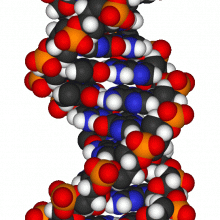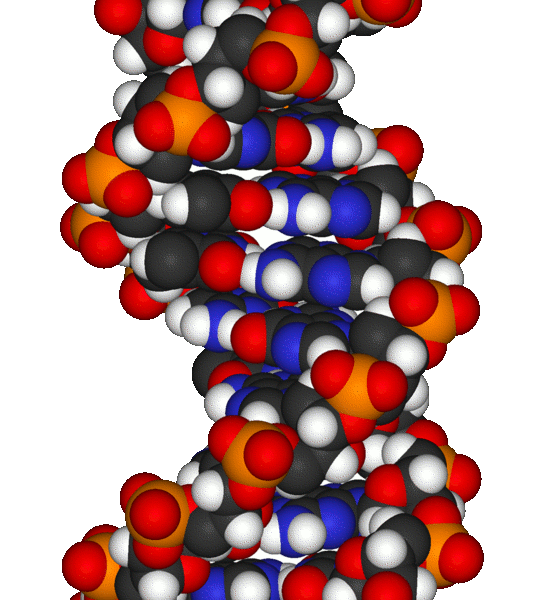In this NewsFlash, we discover a new extra-fast and super-cheap way to sequence the human genome, the science of eating slowly, and fish dining out at the Shark Cafe. Also, we find out how newborns cry with an accent...
In this episode

Gobbling your food could make you overeat
If your mother ever told you not to eat your food too quickly it turns out she was probably onto something. Scientists have discovered that when people eat slowly, more appetite suppressing hormones are released than if they quickly scoff their food. This makes slow eaters less likely that they will want to keep on eating and eventually overeat.
 The team from Imperial College in London and Athens University Medical School in Greece published this study in the Journal of Clinical Endocrinology & Metabolism. They recruited a group of volunteers, who were asked not to eat anything for 10 hours, then come into the lab and eat 300ml of ice cream - a good bowl-full. On two separate occasions, they were asked to eat the ice cream either in 5 minutes, or to nibble at it slowly over half an hour by dividing them into smaller portions that were taken out of the freezer every 5 minutes.
The team from Imperial College in London and Athens University Medical School in Greece published this study in the Journal of Clinical Endocrinology & Metabolism. They recruited a group of volunteers, who were asked not to eat anything for 10 hours, then come into the lab and eat 300ml of ice cream - a good bowl-full. On two separate occasions, they were asked to eat the ice cream either in 5 minutes, or to nibble at it slowly over half an hour by dividing them into smaller portions that were taken out of the freezer every 5 minutes.
Before the experiment began and then for the following three hours, the levels of blood hormones in the volunteers were measured, called ghrelin, PYY and glucagon-like peptide, or GLP-1. These are produced in the gastrointestinal tract in response to food being eaten and all act on a part of the brain called the hypothalamus and are known to play an important regulatory role in mediating feelings of hunger and fullness and so effect the amount of energy intake.
The volunteers were also asked standardized questions about how full or hungry they felt at different points during the study.
Levels of the two hormones, PYY and GLP-1 were both higher in the volunteers who ate slowly, compared to the fast eaters. So, it seems when you eat more slowly, your guts are better at telling your brain that it's time to stop eating.
And the slow eaters all reported feeling much more full after eating their ice cream than the gobblers.
Other past studies have suggested a link between fast eating a body weight in adults and children so now this study has provided the first evidence for the link between the two.
So, perhaps it pays to listen to you mother, and we could all benefit from enjoying eating our food slowly rather than wolfing it right down.

Low cost genomics
As we discover more genes that make us susceptible to developing certain disease or reacting the wrong way to certain drugs, the race is on to come up with very fast systems that can read DNA sequences and at very low-cost.
 It's fair to say that prices have come down a bit since the 100 million US dollar spend that was required to complete the official human genome project, but US $2000 to do the same thing seems almost unbelievably cheap. But that's roughly the price quoted in a paper published in the journal Science from a California-based company called Complete Genomics, who have developed an ingenious method of sequencing genetic material very quickly and very accurately.
It's fair to say that prices have come down a bit since the 100 million US dollar spend that was required to complete the official human genome project, but US $2000 to do the same thing seems almost unbelievably cheap. But that's roughly the price quoted in a paper published in the journal Science from a California-based company called Complete Genomics, who have developed an ingenious method of sequencing genetic material very quickly and very accurately.
Their teachnique involves first cutting DNA into short segments about 400 genetic letters long and then linking small numbers of the segments together using special "adapter" sequences, which are artificial pieces of DNA containing a specific sequence of genetic bases.
The result is a collection, known as a library, of small circular DNA molecules representing the entire genome. Next, a single strand of the DNA is copied using an enzyme called Phi29 polymerase, which generates long coils of DNA called "nanobundles". One billion of these nanobundles are then dotted individually across a special chip about the size of a microscope slide. The surface of the chip is prepared in such a way that it binds to the nanobundles, locking them in place.
Then, to read the DNA sequence, a series of special colour-coded probes are added to the slide. These contain sequences that recognise and bind to the adapter DNA and to the adjacent genomic DNA. When a probe matches one of the genetic letters in the genome it lights up and is "read" by a laser before being washed off and the process repeated to read the next letter.
In this way, one by one, different probes are used to interrogate the DNA sequence letter by letter. This process is repeated many times to read the DNA sequences in the millions of nanobundles. As this is going on, a computer programme is logs the emerging genetic messages and working out which bits overlap with which to piece back together the complete genome.
The result is a highly accurate genome sequence that can be produced rapidly and cheaply.
The team have checked the technique by sequencing three human genomes. According to Cliff Reid, the CEO of Complete Genomics, "We've demonstrated that it's possible to accurately and affordably sequence and detect variants across entire human genomes.
This high-quality, cost-effective approach to genome sequencing will allow researchers to study complete genomes from hundreds of patients with a disease to advance the understanding of the genetic causes of that disease, with an end to preventing and treating common human ailments." Dennis Ballinger, vice president of Complete Genomics, also highlighted the speed and cost effectiveness of the platform. "The nearest competitor to what we're doing currently costs $40,000 per genome and takes 8 weeks. That's twenty times more expensive and 8 times as long as us."

Hanging out at the shark café
Scientists have come a step closer to understanding the mysterious lives of some of the oceans biggest predators - the Great White Sharks - in a 10-year study that tracked nearly 200 sharks as they swim around the eastern Pacific Ocean.
Published by the Royal Society in their Series B journal, the study by a big team of researchers led by Salvador Jorgensen from Stanford University in the US unpicked some great white secrets, including pinpointing their favourite mid-ocean hang out: a spot of sea between Hawaii and the Californian coast nicknamed the shark 'Café'.
The team used a combination of cutting edge satellite tagging technology, acoustic tags that are detected by sensors placed around the Pacific Ocean and DNA analysis of samples taken from wild sharks
Jorgensen and the team discovered that every winter the sharks regularly migrate away from coastal waters off California and head out 4000 km to the warm waters of Hawaii, before heading east again the following summer.
The big question is, why do great white sharks bother swimming so far every year, backwards and forwards, using up so much energy?
And the answer - unfortunately - is that we don't really know. But, researchers think the sharks are probably visiting Hawaii every year to feed since the tags showed the sharks regularly diving down deep probably hunting for prey.
And as for the mid-ocean shark café? It's likely that the great white sharks are feeding and also mating there too. The tagging studies showed males and females mingling in the shark café, at around the right time ahead of females giving birth in likely nursery grounds in coastal waters further east. Great white females gestate foetuses for 12 or possibly even 18 months before they give birth.
The study also revealed that sharks keep on returning to the same area of coastal habitat off the American coast. It's possible that sharks hunt more successfully when they know the area well.
The study also showed that great white sharks in the northeast Pacific are a distinct population from other sharks in Australia and South Africa. This is vital information for conservationists, because even if many people are still scared of these toothy predators they are, sadly, facing an uncertain future because of overfishing. Their large fins are highly prized for the trade in sharks fin soup.
Studies like these are revealing vital details about the lives of great whites, highlighting that they are not simply mindless killing machines milling around aimlessly, but they undergo complex migration that we are only just beginning to understand.

12:37 - Babies are born with their mother's accent
Babies are born with their mother's accent
Dr Kathleen Wermke, University Hospital of Wurzburg
Chris - Scientists at the University of Wurzburg in Germany have teamed up with their colleagues in Leipzig and also in Paris and they found that the cries that young newborn babies emit actually mirror their mother's accents. And to tell us how they discovered that, we are joined now by Kathleen Wermke who is the head of the Centre for Pre-speech Development and Development Disorders and she's at the University Hospital of Wurzburg. Hello, Kathleen.
Kathleen - Hello!
Chris - Welcome to the Naked Scientists.
Kathleen - Thank you.
Chris - What's this study actually show?
 Kathleen - The study actually showed an extremely early impact of the surrounding language, of native language, a foetus was exposed to in the womb. This is, of course, new because we knew since many researchers and investigators that during the last year, that infants are sensitive to prosodic features of the native language long before they are born and that they memorize those patterns as a newborn. But it was not known that they are capable so early also, not only to memorize, but also to reproduce those patterns in their own cries.
Kathleen - The study actually showed an extremely early impact of the surrounding language, of native language, a foetus was exposed to in the womb. This is, of course, new because we knew since many researchers and investigators that during the last year, that infants are sensitive to prosodic features of the native language long before they are born and that they memorize those patterns as a newborn. But it was not known that they are capable so early also, not only to memorize, but also to reproduce those patterns in their own cries.
Chris - How did you do the study?
Kathleen - We recorded the cries of the newborns in Paris and in Berlin in Germany, and then we came back to our laboratory acoustic lab, and we analysed the frequency, spectrogram and the melody contours of the cries, normalized cry time - because not every cry has the same duration - and then we looked for what time point the pitch maximum, the melody maximum was reached. Was that more at the beginning or more at the end of a cry? So we compared between the groups of German and French infants according to their melody contour, having either rising or falling contour.
Chris - Shall we have a listen to some of them?
Kathleen - Okay.
Chris - Well, you sent us some of the recordings you made. So first of all, I'll play the rising cry.
Newborn's Rising Cry
Chris - And here's a falling cry.
Newborn's Falling Cry
Chris - So that's basically one that goes down at the end rather than going up as it goes along. How does that mirror the native language spoken by the mothers of those babies?
Kathleen - It mirrors it because French intonation is characterized by a pitch rise towards the end of several kinds of prosodic units, words or phrases; whereas German, typically, exhibits a falling melody contour.
Chris - And so, why do you think that the babies, when they've got a lot going on in their lives when they're newborns, why should they prioritize being able to mimic mum in this way? Why does this give them benefit?
Kathleen - We think that this observed behaviour is just simply a reflection of the special aptitude human infants have to acquire language. They're hard-wired to acquire language and we know that they have a special sensitivity from melodies and rhythms already being a foetus and then also being born. So we think this is just showing how early language development starts in human infants based on their brain mechanisms and genetic programs, really to acquire language.
Chris - Is this language that they're acquiring in utero? So while they're inside mum and towards the end of pregnancy, they're listening to the sounds and vibrations from her voice being transmitted to them while they're inside and that's where they learn to mimic before they've even been born?
Kathleen - Yeah. That's what we guessed because they are able to listen for three months at least being in the womb and they had only one or two days after delivery. But, of course, we're not sure. Maybe these one or two days after delivery were enough to learn the specific intonation patterns of their surrounding language. We are not sure but we guess that most important are the three months prenatally.
Chris - And in animals?
Kathleen - In animals, it is well known that they have already a lot of prenatal auditive learning. But I'm not sure if anybody checked already the postnatal - the very, very early postnatal impacts of those prenatal learning processes but I'm sure it should be observable in animals too.
Chris - One of the things you say in your paper is that if the baby sounds like mum, she's more likely to bond with it. That seems reasonable.
Kathleen - Probably, yeah. Of course, we don't know but according to the theoretical implication of this study and other studies, it might be that this really fosters bonding between the newborn and the mother, but it seems to be rather unintentional - being just a reflection of the capabilities this human infant has from his genetic programmes and behaviour mechanisms.
Chris - We must leave it there. Thank you very much, Kathleen. That was Kathleen Wermke who's at the University of Wurzburg. She was explaining how babies perceive the general tone of their native language and mimic it even before they're born.










Comments
Add a comment